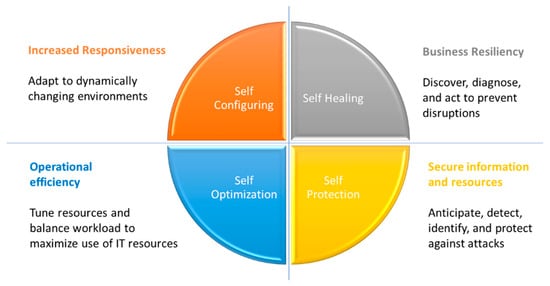Wireless Sensor Network (WSN) is one of the key technologies for IoT implementation. Research and development in IoT are progressing from the research and development in Wireless Sensor Network (WSN) and Mobile Ad Hoc Network (MANET), but still have some specific differences. Compared to WSN and MANET, IoT has a wider scope that includes the device, the communication infrastructure, and the cloud. IoT applications are more diverse. They are different from the WSN and MANET applications, which are domain specific. IoT always involves the internet (IP based network) as the point of interest, so that it often requires multiple network interfaces on the gateway side. IoT also tends to use the existing standard of communication technology infrastructure, which is already available for the internet network.
1. Overview
The autonomic Internet of Things is the creation of self-management capability in the Internet of Things system by embedding some autonomic properties, with the goal of freeing humans from all detail of the operation and management of the system. At same time, this provides a system to always operate on the best performance. This paper presents a review of the recent studies related to the design of network communication protocol, which can support autonomic Internet of Things. Many of the studies come from the research and development in Wireless Sensor Network protocols, as it becomes one of the key technologies for the Internet of Things. The identified autonomic properties are self-organization, self-optimization, and self-protection. We review some protocols with the objective of energy consumption reduction and energy harvesting awareness, as it can support the self-energy-awareness property. As the result, the protocol designs are mapped according to each autonomic property supported, including protocols for MAC layer, protocols for clustering, protocols for routing, and protocols for security. This can be used to map the advances of communication protocol research for the autonomic Internet of Things and to identify the opportunities for future research.
2. Wireless Sensor Network
Internet of Things (IoT) is a global network of various physical devices such as sensors, actuators, and mobile devices, which are connected to the internet and then do the collection, exchange, and processing of data. The IoT envisions a complex system with the purpose to interconnect sensors, actuators, and smart devices in such a way that makes them intelligent, programmable, and more capable in interacting with humans by providing useful services
[1]. IoT makes the realization of various smart service concepts such as smart city, smart grid, smart home, smart building, smart health, and smart transportation
[2].
The rapid growth of IoT has been predicted by Gartner in
[3]. By 2027, there will possibly be over USD 1.463 billion in market size for IoT devices
[4]. The large number of IoT devices will bring out many challenges and complexity.
Some of the challenges for IoT are related to the network infrastructure of IoT nodes. An IoT system consists of many resource-constrained nodes that have limited energy, processing power, and memory. The IoT network is also heterogeneous. It is possible to have diversity in the network architecture and the protocol used by the nodes. The decision of network topology and protocol used may differ from one case to another, to adapt to the condition and the needs of communication. Some types of IoT device may also have mobility, such as wearables, which will follow the user’s position. The number of IoT devices that can join the network can reach a very large number, which should be anticipated by the network. The IoT network is also vulnerable to malicious attack, so that the safety and the quality of information are important. It will be related to some aspects of security, privacy, and trust. These challenges urge more research and development in IoT.
Wireless Sensor Network (WSN) is one of the key technologies for IoT implementation. Research and development in IoT are progressing from the research and development in Wireless Sensor Network (WSN) and Mobile Ad Hoc Network (MANET), but still have some specific differences. Compared to WSN and MANET, IoT has a wider scope that includes the device, the communication infrastructure, and the cloud. IoT applications are more diverse. They are different from the WSN and MANET applications, which are domain specific. IoT always involves the internet (IP based network) as the point of interest, so that it often requires multiple network interfaces on the gateway side. IoT also tends to use the existing standard of communication technology infrastructure, which is already available for the internet network.
Recent research and development of IoT seek answers for the challenges faced by the IoT network through the design and the algorithm of the communication protocols. Various protocol designs were proposed to establish an intelligent system. Some of them are inspired by natural and biological systems, that can make the system self-manage the complexity based on the objectives and the rules set by humans. These protocols embedded the autonomic property into the system for various tasks and activities, such as network adaptation, network organization, energy management, network optimization, and network protection.
3. Autonomic Computing Concept
4. Conclusions
The identified autonomic properties are self-organization, self-optimization, self-protection, and self-energy-awareness. The protocol designs to support these autonomic properties include protocols for MAC layer, protocols for clustering, protocols for routing, and protocols for security. These protocol designs are mapped according to each autonomic property supported, which can be used to map the advances of communication protocol research for the autonomic IoT. We also identified that recent protocol designs nowadays use bio-inspired algorithms. The meta-heuristic behavior of bio-inspired algorithms has become an advantage to solve complexity in IoT networks. The area is still wide open for future research opportunities to discover new or improved algorithms, which can achieve better convergence speed and improved solution precision.
The future research for IoT network infrastructure is expected to solve problems of resource constraint, heterogeneity, mobility, scalability, and security in IoT networks, by intelligent and autonomous means.

